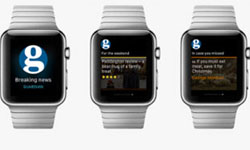“What’s your fascination with this Apple Watch, Mario?,” a long time colleague asked me when I ran into him at the WAN IFRA World Media Congress recently. “It’s your new toy, isn’t it?”
I admit that my Apple Watch and I have been inseparable since I got it five weeks ago. You could call it a toy, if you wish, but I don’t. I see it as a constant companion and personal assistant on my wrist. It is also a laboratory piece for the storyteller and designer in me as I immerse myself in the world of at-a-glance journalism.
That is what smartwatches are all about: glancing. We are not likely to spend longer than 5 seconds looking at our watch. We are not (yet) going to read long texts on the face of a watch. For that we turn to that larger canvas, the iPhone!
While not many members of our audience own a smartwatch yet, I am certain that many will within the next two years. We must learn to write, edit and design for this new platform in the media quintet that also includes the smartphone, online, tablet and print.
What we know about the use of smartwatches to consume news
I have joined forces with those guys at Stibo Accelerator and the editorial team of Berlingske, of Denmark, along with two student researchers from Aarhus University, Ganesh Ram and Jonas Skytte, for what is considered the first testing with readers using smartwatches.
The results are not surprising. These are the highlights:
—We glance at our watch for a headline, sometimes longer to see related bullet points, but not much more than that. If the editor has provided us with two or three decks to flesh out the story, that is all we need. The New York Times does it best, with Bloomberg News a close second.

The New York Times: Easy to read and well edited blurbs that start with a lead headline and are followed by either one or two decks to add information. Usually, that is all a reader knows for the story at a glance. (illustration courtesy of Garcia Media)
—We follow a story. Incorporate that one story of the day that is likely to peek our interest for a sustained period of time. The Washington Post does this best, starting our day with the one centerpiece article they think will grab my attention. A recent one about dying honeybees, and the uncertain future of honey, did that for me. In fact, it has been the only time since I got my Apple Watch that the alert on the watch lured me to read the article on my iPhone.
—We don’t like too many intrusive alerts: too much intrusion may irritate those smartwatch users. Don’t notify users with irrelevant and uninteresting information. “The art of usefully interrupting someone with news is turning into one of this century’s key journalistic skills,” writes Joshua Benton for
the Nieman Lab.
—We like the practicality of the smartwatch :
Instead of getting their smartphone out, participants agreed that it was much more practical to quickly and easily see a notification when received on the smartwatch, and then to determine to dismiss it, act on it, or let it wait for later. This is true when one is riding a crowded New York City subway, where I have experienced the difficulty of getting my iPhone out of my coat pocket, but now simply glance at the watch to get that headline.
The smartwatch and the editor and designer
I have no doubt that the smartwatch will be a popular and useful platform for our audiences to get news and information.
Remember that this is only the 1.0 version of the Apple Watch. There are likely to be improvements made to this one, not to mention the many other brands that will bring their smartwatch products to market.
We must be prepared to have mini editions of our publications on the face of that watch. It’s eyes on the wrist for our readers.
How to prepare?
1. Start thinking how your brand will carry into some type of presence in smartwatches.
2. Create a distinctive edition, capitalizing on your publication’s best coverage. Not everything you present on the smartwatch needs to be breaking news. Emphasize the element of surprise, as do The New York Times and The Guardian in their current smartwatch apps.

The Guardian: Selects some stories each day and uses labels such as “In Case You Missed It”, or “Something for You.” (Graphic courtesy of Garcia Media)
2. Use photos, but make sure that they are simple images that do not show too much detail or crowded images. Head shots do well.
3. Use the smartwatch edition as a way to keep your brand in front of your audience.
4. Avoid using type over photos. Emphasize legibility, which I personally think is best with black backgrounds and white letters.
5. Of course, get your own smartwatch pronto and start studying it from the point of view of a storyteller/designer. You will find that it is the most enjoyable homework you were ever assigned.
Dr. Mario Garcia is CEO/Founder of Garcia Media and Senior Adviser for News Design at Columbia University School of Journalism. He is a member of the Poynter Foundation Board.








